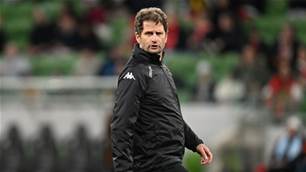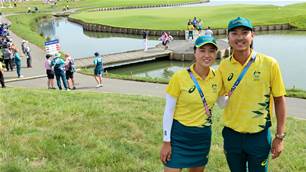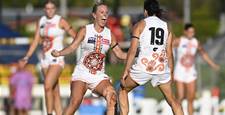Australian football has had some wonderful players who are household names and are part of the rich tapestry of our sporting history.
We talk about Mark Schwarzer, Craig Johnson, Tim Cahill, Harry Kewell, Mark Viduka and so on. These men and quiet a few more are rightly considered legends of our game.
However, how often do we celebrate the fantastic women who have endured far more challenges in representing their country than most of the men who have pulled on the Green & Gold?
However, how often do we celebrate the fantastic women who have endured far more challenges in representing their country than most of the men who have pulled on the Green & Gold?
The top six names when it comes to appearances for Australia are women. Cheryl Salisbury leads the way with 151 games over a 15 year career. Goal scoring record holder Lisa De Vanna (150), Heather Garriock (130), Clare Polkinghorne (125), Elise Kellond-Knight (113) and Joey Peters (110) have all earned more caps for Australia than any other male in the history of Australian football.
Schwarzer with 109 games leads the way for the men, one ahead of all time leading goal scorer Cahill.
Melbourne City defender Chelsea Blissett, touted by many as a future Matilda, urged fans to take note of who’s gone before them in women’s football.
“I think that it is important to celebrate legendary women in Australian football,” says Blissett, who was part of the Young Matildas set up last year. “These women put in the same amount of hard work and dedication as their male counterparts.
“They sacrificed a lot to move the game forward and become Australian football icons.”
Women’s football is now part of the mainstream sporting landscape in Australia. It should be talked about just like the men's game.
The fans should talk about Salisbury. The girl from Newcastle who played in four World Cups and went to two Olympic Games. In 2019 she became the first female footballer to be inducted into the Sport Australia Hall of Fame. What about Peters? Also a Novacastrian who is widely regarded as the best women’s footballer Australia has produced, she was the first Aussie to play professionally in South America as well.
Who knows about Sandra Brentnall? The Nottingham-born immigrant who scored Australia’s first ever international goal at Seymour Shaw Park in 1979.
Let’s not forget Shelley Youman, the Townsville-born but Lake Macquarie-bred survivor of childhood domestic violence, who played 20 times for Australia after she married and had three kids.
“I think it is a huge inspiration hearing about these women, especially Shelley,” admits Blissett. “I think women athletes find it hard to have a family and continue with their professional careers and as someone who hopes to start a family one day, it shows that as a female athlete you can still compete at the highest level and have kids.”
We also need to celebrate some iconic occasions from yesteryear for the Matildas like the 1998 remarkable trip to North Korea for a three game series. Against the odds, Australia returned from Pyongyang with a series win, drawing 0-0 in the first two games before a 1-0 triumph in the third courtesy of Julie Murray’s 72nd minute winner.
What about the win over Greece at the 2004 Athens Olympics, with Garriock’s winner sending Australia to the knockout stages for the first time at an Olympic Games?

Or this one, Salisbury’s 92nd minute equaliser in front of 30,000 screaming fans in Chengdu as Australia drew 2-2 with Canada at the 2007 World Cup in China, a result which saw the Matildas make the knockout stages for the first time at a World Cup. Canada had taken the lead in the 85th minute.
A few days before this, Australia had beaten Ghana 4-1 in Hangzhou to claim their first ever win at a World Cup in what was their fourth appearance. De Vanna scored a double that day, shades of Tim Cahill’s legendary goals against Japan in Kaiserslautern a year earlier.
In the 2010 Asian Cup Final, Kyah Simon did a John Aloisi and nailed the winning penalty in a dramatic 5-4 shootout as Australia beat old nemesis North Korea to win their first ever Asian Cup. Simon’s penalty should be shown as much as Aloisi’s strike or James Troisi’s winner for Australia in the 2015 Asian Cup final.
In more recent times, the first win against powerhouse USA in 2017 where Tameka Yallop lashed home a winner, transcended women’s football in this country. That tournament also turned Sam Kerr into a genuine superstar.
“These goals should be talked about,” agrees Blissett. “They don’t get talked about the same way as certain men’s goals at the World Cup, however as the women’s game has grown there needs to be more celebration of iconic goals like these.
“I do also think however, instead of focusing on the past only, we should be focusing on how the women’s game has changed and keep celebrating how far we have come.
"But in saying that we do need to celebrate the Matildas of the past to show our thanks for the sacrifices they made as they led the charge for female football.”
As Blissett says, all of these great moments and great players should be part of the legendary occasions we look back on with great fondness. This is how we build respect for women’s football. Little girls, and boys for that matter, need to know about all of this so they can see that women’s football is much more than just a gimmick. It’s been around for nearly 100 years.
In September 2021 we will celebrate a centenary of highs and lows, thrills and spills. It’s all part of our momentous history, let’s celebrate it.
Related Articles

'Timing not right': Montemurro's verdict on Matildas vacancy

Min Woo backs Minjee to win the medal that eluded him













